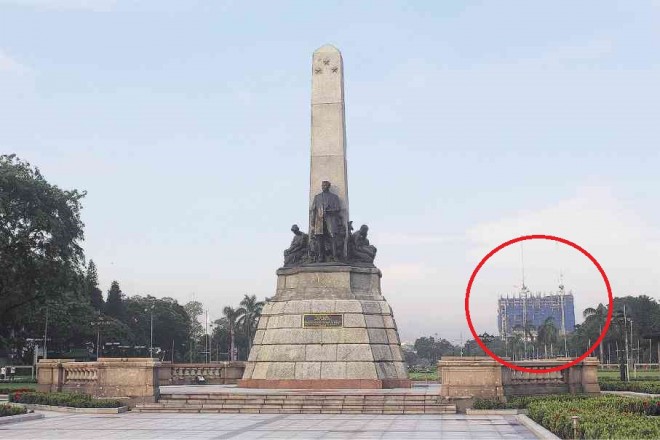
TAKING its own photos of Rizal Monument and Torre de Manila (encircled), DMCI says “one may stand near the monument and choose certain angles to avoid or, at the very least, minimize the building’s intrusion.” PHOTO FROM DMCI
Breaking its silence, the developer of the controversial Torre de Manila maintained that the project stands on solid legal ground and claimed that media photos of the rising condominium were part of a mere “propaganda” to make it appear very close to the Rizal Monument.
DMCI Project Developers Inc.—a company under the Consunji-led DMCI Holdings—stressed that the project had obtained all the required permits and approvals.
The company issued a statement on Tuesday, four days after the Knights of Rizal filed a petition in the Supreme Court seeking Torre’s demolition for ruining the view of the national shrine.
DMCI lamented that complaints against Torre had centered on the project becoming part of the background of the Rizal Monument, which it said had nothing to do with the law.
“Our project is almost one kilometer away from the monument and even a bit on the right side. But to grab public attention, some parties took to the unethical approach of virtually juxtaposing pictures of our project right behind the monument,” DMCI said, without naming the parties.
“In effect, their claim of ‘photobomb’ (or Torre being an intrusive object that ruins a picture) was photoshopped. It was a success as far as getting the public to believe their propaganda, but it was at the expense of truth,” the firm said.
“ONE MAY stand near the monument and choose certain angles to avoid or, at the very least, minimize the building’s intrusion,” DMCI says.
PHOTO FROM DMCI
DMCI attached to its statement photos showing what it considered the “actual” relationship or distance between the project and the Rizal Monument.
(The Inquirer stands by the integrity of the photos used for earlier reports on the Torre de Manila controversy.)
“Our zoning permit, issued on June 19, 2012, specifically allows us to build 97,549 square meters. This was confirmed when the building permit was issued the following month showing that we were cleared to build a 49-story project (not 46, as earlier reported),” DMCI said.
The statement noted that in September 2012, the Manila city government’s legal department opined that “aesthetic offensiveness” was not among the legal bases that would merit the suspension of the project. The opinion was issued in response to the request of the city council then to suspend the building permit.
DMCI further noted that by November 2012, the National Historical Commission cleared the project, saying it “is outside the boundaries of Rizal Park and well to the rear (789 meters) of the Rizal National Monument.” But for future projects, it said it might ask the city government to designate a buffer zone around the park and regulate building development.
Finally, the company said the present city council confirmed and ratified all the permits and approvals issued by city hall for the project early this year. “For all intents and purposes, we are legally solid,” DMCI said.